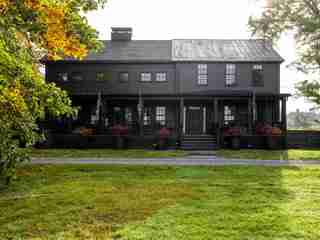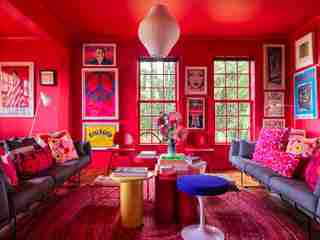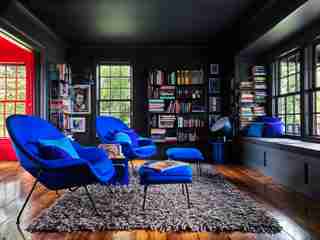In his 1963 treatise Interaction of Color , Josef Albers observed that the most fascinating thing about colors is witnessing them shift in situ. “Colors present themselves in continuous flux,” he explained. “[They’re] constantly related to changing neighbors and changing conditions.” Meditating on this phenomenon, Bradford Shellhammer, vice president of buyer experience at eBay , will tell you, also has a way of changing those who slow down enough to witness it.
Albers’s theory is brilliantly manifest at a 13-acre Stuyvesant, New York countryside retreat, which Shellhammer and husband Georgi Balinov own. In a few short months, they transformed the 1840s three-bedroom farmhouse and the property’s eight (yes, you read that right) additional structures into a modernist Eden, with all the amenities for hosting their family and friends just two and a half hours from Manhattan. As a charming signpost indicates, there’s a swimming pool, sauna, network of bars and lounges, movie theater, and vegetable patch, not to mention an abundance of quiet spaces. The estate’s name, Rode Barns, comes from the three showstopping stables, painted in vivid hues inspired by Alber’s 1943 oil painting, Related (red) .
“The idea really came from the light,” says Shellhammer, who also owns an equally eclectically-designed loft in Manhattan . “Because the barns are different shapes, the sun hits different angles in interesting ways. You could see the colors change throughout the day.”
Giving the property’s old horse stables a proper refresh entailed committing to hundreds of gallons of paint. Shellhammer, who shares Albers’s acuity for color, worked with the Josef and Anni Albers Foundation to get the shades of vermillion just right. “We thought the barns would offer a wonderful opportunity to play with the interaction of color and paint,” says Lucy Swift Weber, the foundation’s head of licensing, who got to know Shellhammer while working on a textile project for his former design start-up, Fabom. (Weber’s been thinking about developing a line of house paints based on the Albers’s experiments, and Rode Barns was a chance to experiment on a grand scale.)
Never one to shrink from a bold gesture, Shellhammer explains that he initially contemplated painting the barns in neon pink and orange, inspired by Luis Barragan’s candy-colored horse stables in Mexico. Weber “talked him off the cliff,” as he puts it, and steered him towards Albers’s subtler chromatic gambit.
Choosing colors wasn’t just the only challenge Rode Barns presented. The scale of renovating the entire property was intimidating, even for Shellhammer, who loves to periodically redecorate his apartments like a living showroom. Balinov, who usually entrusts design decisions to Shellhammer, got involved in Rode Barns’s transformation. With the help of a local foundation that trains people in the tenets of farming, he took charge of nurturing a victory garden, as a nod to his family in his native Bulgaria, who grew their own food.
Shellhammer says tackling a big project together was a form of solace. “I think Covid-19 just disrupted something,” he recalls. “We both felt we needed to do something.” As arduous as it was, Shellhammer describes the process as invigorating, even affirming. “The thing I took away from it was that my gut instincts were all correct,” he says. “Of course there were these unexpected blips along the way, but more or less, it all worked.”
Resisting the inertia that comes from indecision propelled the renovation or any endeavor forward, Shellhammer says. “It’s not just decorating, it’s a life strategy of mine,” he explains. “I think that a big part of my professional success has to do with just being decisive. Making a decision, even if it’s the wrong one, gets you away from this constant state of paralysis. If you make a mistake, at least you can react to it and that ultimately gets you on the right path way faster.”

Black on black. The house’s jet black façade is a foil to the colorful interiors. It’s also a modern twist on the traditional farmhouse. Shellhammer says the property’s former owner once came to visit and joked that her old farmhouse now looks like “a woman wearing too much mascara.”

Shellhammer’s design treasures, collected over the years, find a home in the hot pink living room.

Pops of Yves Klein blue can be seen in the adjacent sitting room.
Another striking interior.
An Andy Warhol cow screenprint can be seen in the dining room.
Of all the rooms in Rode Barns, Shellhammer often finds himself in the kitchen, working from the extra large island looking out at the barns and the gardens.
The wood for the kitchen countertop was reclaimed from a small barn that was knocked off the property.
“I wanted the stairs to pop and look like liquid candy flowing down,” Shellhammer says. “It’s really glossy, you’d almost wanna kinda lick the steps when you go near it.”
Shellhammer’s mastery for marrying high-end and affordable design shines in the primary bedroom. Isamu Noguchi side tables flank a surprisingly inexpensive bed frame, with Max Lamb’s stools on the foot of the bed. The dressers are from IKEA . On the wall are works by James Victore, Dan Stiles, and the Philadelphia design studio, strawberryluna .
A tranquil nook in the primary bathroom.
Floor to ceiling Marimekko prints cover a guest room.
More of Shellhammer’s eclectic art collection is showcased here. Bedding is Marimekko.
The Bauhaus-inspired neon ceiling mural was painted by Rode Barns’ first artist-in-residence, Luis Urribarri. “This is the money shot of the house,” says Shellhammer.
The victory gardens. The Rode Barns complex includes a vegetable garden, established with the guidance of the local non-profit FarmOn! Foundation .
The “rode” in Rode Barns is a homophone of the Dutch word for red— an allusion to the Dutch East India Company, which funded Henry Hudson’s most fruitful expeditions to North America. Hudson is of course the namesake for the area’s famous nearby river.
Bradford Shellhamer at Rode Barns. “Apart from the sushi, I don’t miss the city much when I’m here.”
A disco ball and an RS Barcelona foosball table, named in honor of the English explorer who landed in Stuyvesant in 1609, make statements in the designated “party barn.” A DJ booth will be installed in one of the barn’s four horse stables.
Shellhammer loved Dorian Corey’s rousing aphorism, “If you shoot an arrow and it goes real high, hooray for you,” from the documentary Paris Is Burning, so much that he had it translated into pennants. “It’s about trying to do something,” he explains. “You don’t always succeed, but trying is what it’s all about.”
A pop of red barn can be seen from the swimming pool area.
The pool house was converted into a home office.
Shellhammer kept the original white exterior in a small guest house at the back of the property.

Leave a Reply